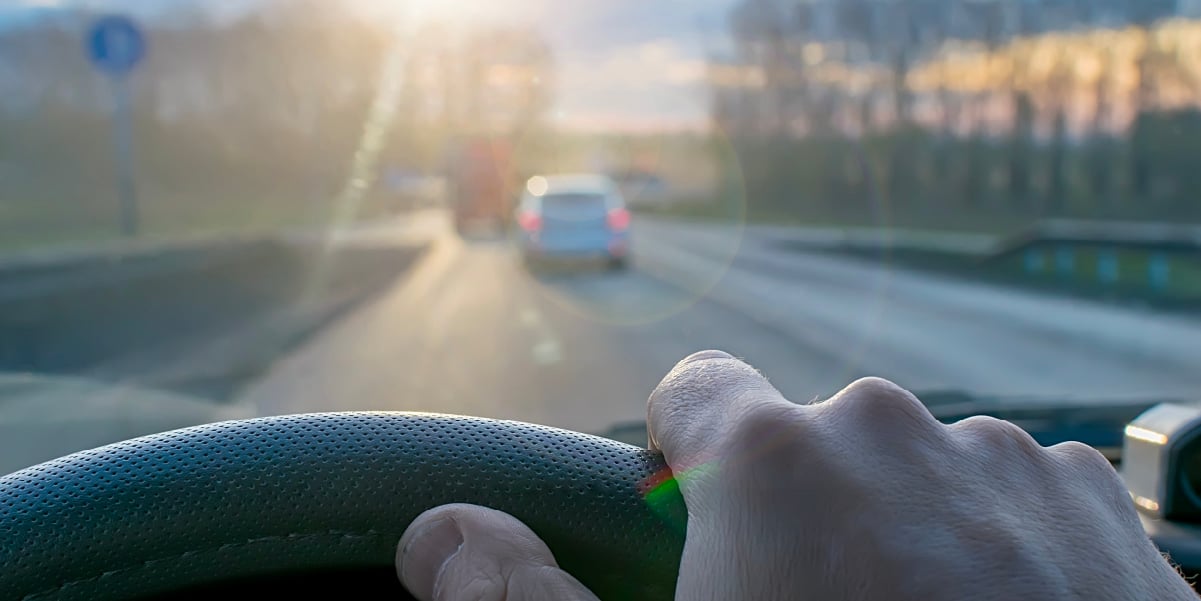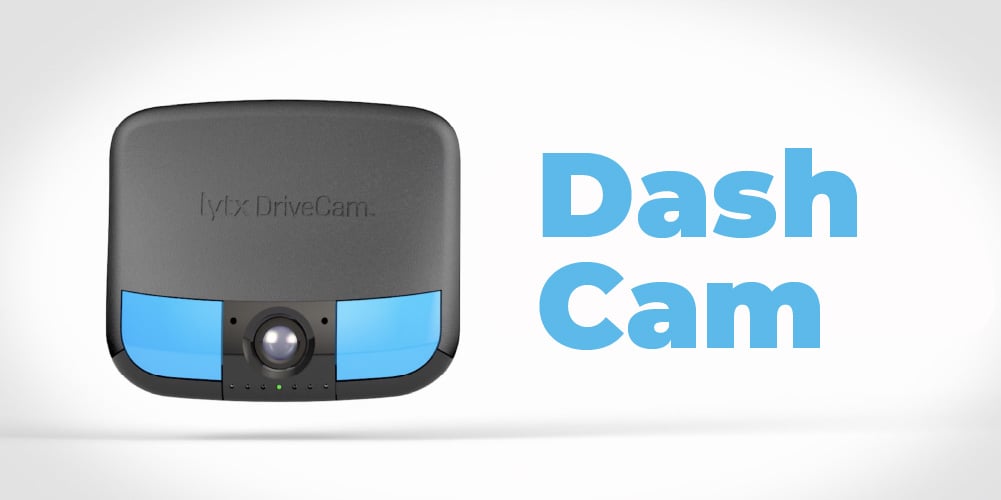Forward-Facing Truck Dash Cams: Everything You Need to Know
Nathaniel Leis is the director of safety for ATS. With 16 years of experience in the transportation industry, Nathaniel has worked with Behavior Based Safety programs, OSHA compliance programs, injury prevention and management, facility safety, organizational safety, regulatory compliance with the FRA and FMCSA and operations management. Nathaniel spent the first 12 years of his career in transportation in the railroad sector managing employee safety, facility safety, environmental compliance, intermodal operations and contractor safety for BNSF railway and TTX companies. Nathaniel joined the trucking industry in 2018 with ATS where he works with the operations departments in building and sustaining safety and regulatory compliance programming for ATS and its affiliate companies.
Imagine this:
You’re cruising down the road at a cool 65. “Free fallin’” is on the radio and you’re bopping along. Your foot is tapping, you have plenty of fuel and you’re set to arrive at your next customer’s site well before you need to and you’ll pick up your next load shortly thereafter.
It’s a good day to be a truck driver.
Until it isn’t.
Suddenly, your day flips upside down. A car zooms in front of you — one of those zippy little red sports cars where the driver is too cool for school — and promptly makes a lane change just feet in front of you. Then, horror of all horrors, they slow down. The car in front of them has slammed on its brakes.
You can’t stop in time. Now instead of cruising down the road, you’re cruising into the back of Mr. Fancy Sports Car Guy. Instead of enjoying classic rock on the radio, you’re in the middle of an accident. And the worst part of it is that the motorists on the road think you’re the one who caused the accident and so does the responding officer on the scene.
You immediately know that you’re going to be slammed with a ticket and you’ll be liable for the property damages and personal injuries. You know your trucking carrier and your dispatcher won’t be happy with you, and this accident could cause you to lose your job.
Except…
Wait.
You’re driving for a carrier that has safety at the forefront of everything they do. That’s why they have forward-facing cameras in all their trucks. Your hard brake triggered an event, and the camera sent a clip of the footage to your safety team. The safety team sent the footage to the officer at the scene of the accident. They find out that you’re not at fault. The sports car had a last-minute lane change and cut you off.
The fault is placed on the driver, and the officer tickets the other vehicle. You aren’t in trouble, and there won’t be any points against your safety score.
But wait, there’s more:
It turns out that Mr. Fancy Sports Car Guy was driving without a license and the car wasn’t insured. The driver isn’t just getting a ticket — he’s getting arrested.
That forward-facing camera not only saved you from being liable for repair costs, it also saved other motorists on the road from encountering the unlicensed driver.
Unfortunately, this situation occurs more often than you may expect. Front-facing cameras save drivers from tickets, expensive repairs and even the potential for jail time.
There are a number of reasons why you, the driver, may not prefer to have a camera in your truck monitoring your driving behaviors, but they’re designed to keep you safe.
As the director of safety at Anderson Trucking Service (ATS), I’ll tell you what a forward-facing dash cam is, how events are triggered, what trucking carriers are looking at the cameras for and common driver complaints about cameras.
You’ll understand the importance of front-facing cameras and you’ll seek carriers that focus on safety and your improvement as a driver.
What is a Forward-Facing Dash Cam?
Driver dash cams made by brands like Lytx and Samsara are video systems that record continuous footage and provide reliable video evidence to protect drivers and the trucking carrier.
The drive cams record continuous video that can only be stored for up to a certain number of hours. For instance, 100 hours of footage are stored with the Lytx device. The footage is constantly being overwritten. For instance, something that was recorded 99 hours ago will be lost once another hour passes. Footage from more than four days will be overwritten as new footage is captured.
Cameras can be forward-facing, driver-facing or dual. For the purpose of this article, we’ll be talking about forward-facing dash cams.
Some cameras offer live streaming so that carriers can see what’s happening around the vehicle in real-time. Some carriers may do this to get a sense of how bad the weather is and to monitor if drivers need to be off the roads.
Other cameras may also come equipped with manual record buttons so that drivers can record footage when needed.
Wide-angle lenses allow the camera to capture exactly what the driver is seeing out on the road in front of them. They are equipped with low-light visibility so that they are effective at capturing footage even at night.
While the cameras are continuously recording, they are triggered when a specific event occurs. The safety team then reviews the footage, which acts as proof of what really happened.
Trucking carriers are not monitoring all 100 hours of footage — they’re simply monitoring the footage that is sent after an event is triggered or when there’s an accident.
What Events do Carriers Monitor?
Specific incidents on the road will trigger the camera to send a snippet of footage to your safety department for review.
Risky behaviors that trigger an event include:
- Hard braking
- Lane departures (without signaling)
- Close following distance
- Driving over the speed limit
There are a complex set of triggers designed to set off the system to send a snippet of footage. Dash cams like Lytx use machine vision and artificial intelligence (MV+AI) technology to detect risky behaviors.
A G sensor will measure G-force in order to monitor acceleration or sudden deceleration. This may signal a hard brake, which is considered an event that your safety team will review.
If your truck is veering left to right on the road or completely departs out of a lane without signaling, an event is triggered. This may alert the trucking carrier of reckless or inattentive driving. To distinguish between inattentive driving and a turn, the system is wired to blinkers through the engine control module (ECM) in your truck. If you have blinkers on, an event won’t be triggered.
The dash cam system is integrated into the ECM of your truck. It compares your GPS location via a cell tower to a database of speed limits on the roadway. If you’re exceeding the speed limit by a certain amount, it will take a video snippet and send it out.
A collision mitigation system and MV+AI track your following distance. It will compare the distance between the camera and the vehicle directly ahead of the truck. If you’re following too close, you’ll trigger an event. Following too close can be the difference between avoiding an accident and causing a pileup.
The Federal Motor Carrier Safety Administration (FMCSA) has outlined safe following distance standards to avoid collisions. These systems are set up to allow carriers to identify driving habits that do not meet those standards and to coach and support their drivers to improve their following distances and driving habits to meet those standards.
When an event is triggered, a snippet of footage from before the event and after the event is sent to be reviewed — usually resulting in about twelve seconds. If there is a more significant event, such as an accident — fatal or otherwise — carriers may review upwards of five minutes of footage to gather a picture of what really happened.
It’s also important to note that sometimes certain events might not have triggered the system to send a snippet. Sometimes an accident might not be triggered, such as your truck getting clipped in the parking lot of a truck stop.
Despite the fact that an event wasn’t triggered, the camera is recording and you can access that footage to act as proof. With a date and time stamp, you can access the footage you need and determine who may have backed into you.
Each carrier is looking at different triggers and events and they’ll have different safety standards. Typically, events are sent for human review before the trucking carrier gets it. Certain technology brands, like Lytx, do this so that trucking carriers don’t spend excessive time reviewing footage that may not be an event.
Why do Trucking Carriers Use Forward-Facing Cameras?
There are countless benefits of using forward-facing cameras. First and foremost, it captures valuable evidence. In case of an accident, the trucking carrier gets to see what happened in front of the truck and see exactly what you, the driver, saw.
As mentioned in the story earlier, front-facing cameras can save the driver. There are numerous videos of cars cutting off semis and causing accidents, rather than the other way around. This is a huge benefit for drivers and can really save you from being blamed for something that isn’t your fault.
Front-facing cameras are a great way to coach drivers and improve unsafe driving behaviors. The top two factors present in serious accidents are speed and following too closely. Those behaviors can’t be managed easily without a camera.
With a front-facing camera, safety teams can observe driving habits and then they can spend time and effort helping the drivers improve their behavior. Instead of implementing company-wide policies, the trucking carrier can coach each driver individually on whatever their specific driving habits may be. This way, change happens on the driver level. It keeps not just the driver’s safety scores high, but the carrier’s as well.
This method of coaching gives both the trucking carrier and the driver a chance to be more of a team. Typically, drivers are working alone. Seeing these snippets of footage can bring everyone together as a team to discuss vision and expectations together and to be united in our mission to provide safe transportation.
The trucking carrier can work with the driver to make changes and not just drive improvement with the driver, but with the fleet and the company overall. It’s about building skills and techniques that bring forth positive results.
Similarly, drivers who do a great job but are not usually rewarded can be given recognition when they perform at a high level. For instance, an event may be triggered and the safety team will be able to see how a driver expertly controlled their tractor-trailer to avoid a collision. They’ll see that their drivers are doing exactly what they were trained to do.
While it is not required by the government to have cameras in the trucks, the court of law makes them necessary. The exposure to carriers has skyrocketed in the last ten years and the criminal risk to drivers has also elevated. Drivers who are deemed criminally negligent in a crash are spending a long time in prison.
Trucking companies found negligent in the court system are being held accountable with extreme financial penalties to the tune of hundreds of millions of dollars. The industry struggles to find insurance to cover these potential losses and most are not insured above a certain cap.
Many of you may have heard of a recent $1 billion verdict against two trucking carriers that were deemed responsible for the death of a 19-year-old by failing to follow safety regulations and hire safe drivers.
That settlement exceeds insurance caps by many hundreds of millions of dollars. It makes civil liability an existential threat to any trucking company. All but the very largest carriers would fold under the weight of such a judgment. Without actively working to improve and protect lives, a trucking carrier may very well end up with a verdict that destroys them.
Once people’s lives are impacted and an accident enters the legal system, it matters what everyone involved did. What decision did they make in the driver’s seat? How did the company act? How did these actions lead to the accident? How could the accident have been prevented?
An evidence-based capture system, like the front-facing dash cam, along with a coaching plan in place, are methods a carrier can use to protect motorists, their drivers, and the company. You may have been responsible for an accident, but you have also been working with drivers to make good driving choices and to improve safety performance.
These systems enable both companies and drivers to learn and improve from crashes, near/miss events, and observable behaviors. These systems give carriers and drivers the ability to take action to improve based upon identified driving habits, which then makes it possible to improve performance and reduce exposure to potential accidents.
For example, by managing following distance and speed, carriers give drivers more time and opportunity to avoid crashes that happen due to not having enough time and distance to safely react.
By learning from our experiences, carriers and drivers can create repeatable and sustainable results — delivering safe transportation solutions.
Front-facing cameras with a coaching system in support serve to protect the lives of drivers, the lives of other motorists, and the lives and families of those that depend on the company for employment.
If you ask any carrier about their accidents rates after implementing front-facing cameras. Chances are, the severity and number of accidents have plummeted.
Why Don’t Drivers Like Front-Facing Cameras?
Cameras can definitely feel like an invasion of privacy for drivers, but this is more so a big concern with driver-facing cameras and audio. Still, even a front-facing dash camera can feel like an invasion of privacy to some drivers.
Drivers may feel like they’re being watched. They may worry that they’re going to be disciplined and they don’t want to get in trouble. They may even feel like their carrier doesn’t trust them.
This is usually a mischaracterization of the carrier, as most carriers are implementing cameras to improve performance to a specified standard.
What About Driver-Facing Cameras?
Some carriers may elect to not only use front-facing cameras but audio and driver-facing cameras as well.
Many drivers — especially those that have been driving for decades — feel like the cameras are a privacy invasion.
Some carriers specifically use driver-facing cameras for safety reasons. For instance, they may use them to monitor the handling of highly flammable hazardous waste, security-sensitive shipments and local drivers.
Carriers may be monitoring specific behaviors, including:
- Eating while driving
- Seatbelt use
- General inattentiveness
- Cell phone usage while driving
- Road rage
- Drowsiness/sleeping at the wheel
Trucking carriers use this footage for driver coaching.
Drivers that became truck drivers for freedom and independence may take issue with the invasive feelings driver-facing cameras and audio can provoke. In fact, driver-facing cameras and audio may be the reason some drivers opt to find a new carrier.
If you’re unhappy about a driver-facing camera, ask yourself why. Is there something you’re doing that you don’t want your trucking carrier to see? Are you doing something that might put you at risk?
Keep On Trucking!
By now, you have a clear understanding of what is at stake if you drive without a camera monitoring the road. Front-facing cameras not only help you improve as a driver, they help keep other motorists safe on the road.
If you have further questions about the difference between forward-facing cameras and driver-facing cameras, contact a driver recruiter to learn more.
If you’re ready to work with a carrier that values safety, check out all the other safety measures that ATS has in place to keep you and other motorists safe.



